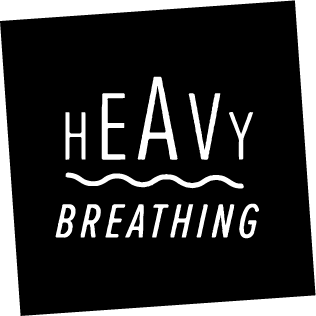June 1-9, 2020
SFMOMA TAKEOVER
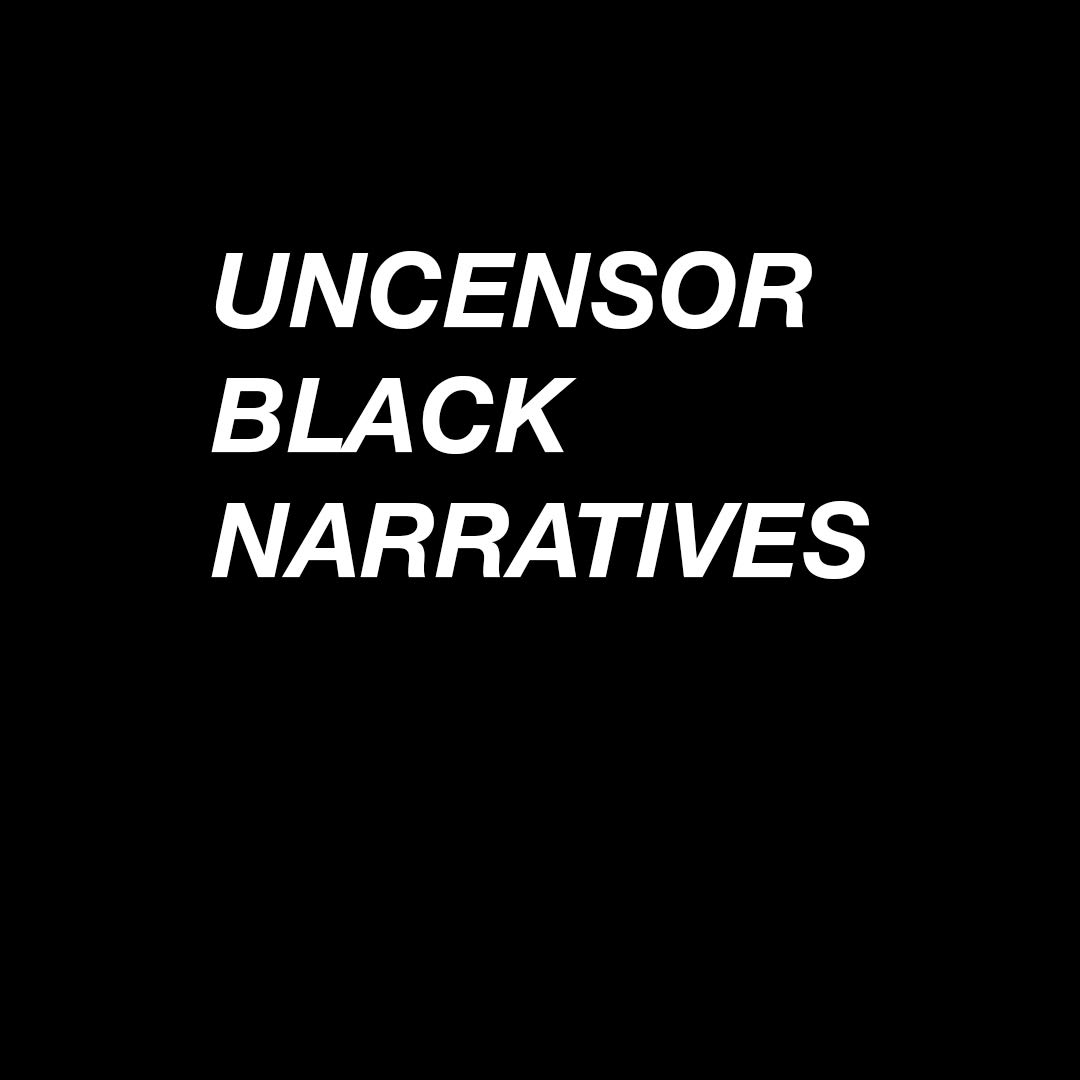
Image credit: Leila Weefur
Heavy Breathing was included in SFMOMA’s #museumfromhome Community in Residence initiative in early June. The program engaged six art collectives to respond to the question, “What does it mean for artists to work collaboratively in the time of social distancing?” As a response, Heavy Breathing commissioned an online public event, “How to Eat Blackberries,” a survey of Black consumption, created by artist Leila Weefur, and writer/curator Elena Gross.
This project was scheduled to go live on SFMOMA’s website on June 4. In light of recent events at SFMOMA, Heavy Breathing, along with our featured artists Leila Weefur and Elena Gross, ended our residency with SFMOMA early, in solidarity with Taylor Brandon and our fellow SFMOMA Community in Residence collectives: Nure Collective, Prison Arts Project, CTRL+SHFT, Work More! and Bik Van Der Pol.
We look forward to presenting Leila Weefur and Elena Gross’s event, How to Eat Blackberries, at a future date, and on a different platform (stay tuned). The integrity, vision and efforts of the people we have been in dialogue with during this time are inspiring and empowering. Thank you to current and former SFMOMA employees, SFMOMA Union, our fellow resident art collectives, and our expanded art communities.
This local act of protest against SFMOMA’s institutional racism sits within the broader context of national protests against the violence that structural and systemic racism continue to deal to Black individuals and communities. We have no doubt that the conversations and actions launched this week in the streets and in our communities will be foundational to ongoing alliances and efforts towards racial justice and equity. We are proud of what we accomplished this week and we thank our extended community for your support and wisdom.
We stand in solidarity with everyone who is standing against violence to Black lives and repression of Black voices.
Additional accounts of these events can be found in KQED, Hyperallergic, NY Times, SF Chronicle, and MSN.
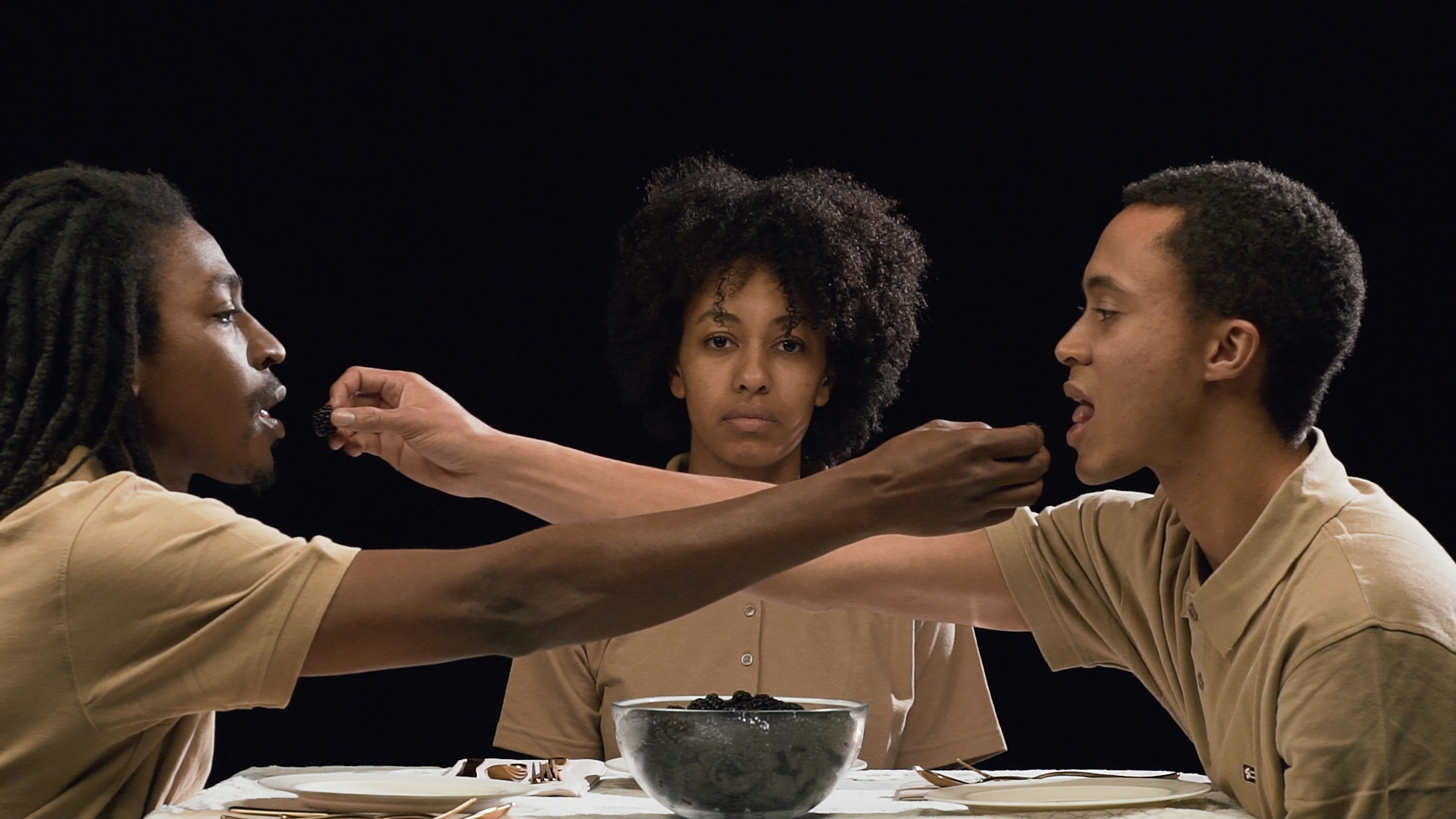
Image: Leila Weefur, How to Eat Blackberries
HOW TO EAT BLACKBERRIES
For the SFMOMA Takeover, Heavy Breathing commissioned How to Eat Blackberries: a participatory instructional led by Leila Weefur with special guest Elena Gross. How to Eat Blackberries is a survey of Black consumption in a ceremony of dining etiquette. Weefur and Gross set the table to weed the fugitive language of Black performativity.
From June 1 to June 9, the public is invited to call (415)618-3281 to reach The Blackberry Hotline, featuring a four-course dinner story on flavor, desire and hunger.
MOVE YOUR THINKING
Move Your Thinking (2020) features contributions from our community and documentation of Heavy Breathing workshops presented between 2015-2020. Edited by Justin Carder.
Thanks to everyone who sent us footage: Crystal Barr, Michelle Cable (and Laurence!), Amanda Cadogan, Ben Carroll, Elizabeth Chodos, Tina Hittenberger, Aida Lizalde, Olive McKeon, Grace Rosario Perkins, Kate Pruitt, Clarke Selman, Lauren Selman, Peter Simensky, Zoe Taleporos, Martin Yernazian, Danielle Wright, and Tip the dog, and Fonda the dog.
WORD PLAY
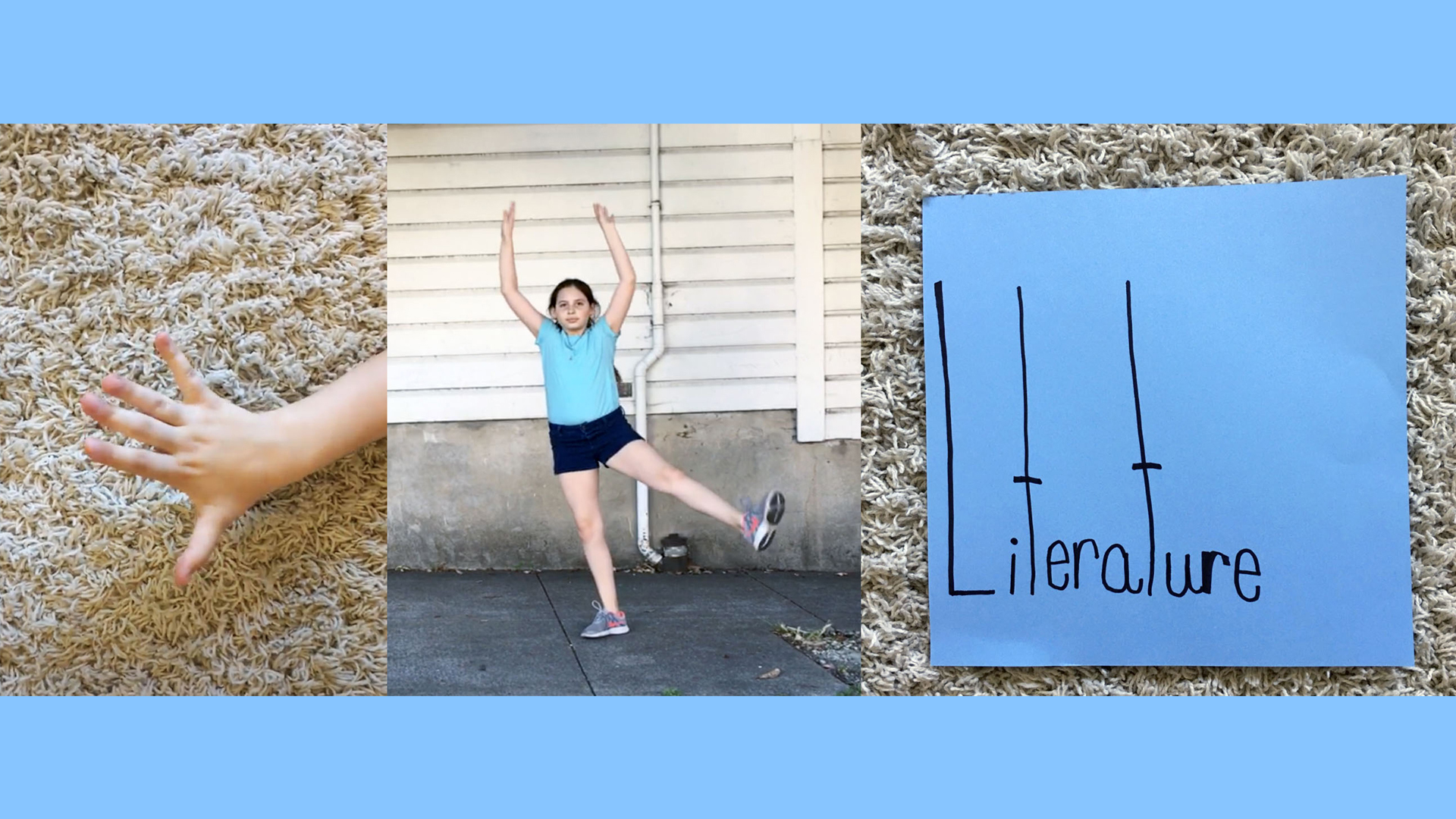
Image: Heavy Breathing’s family activity, “Word Play” featuring Ruby.
Heavy Breathing presents “Word Play,” an all-ages activity that asks participants to think with their body about words.
1) Pick a word. It could be:
2) Write that word down on a piece of paper.

Example by Ruby
3) SHAPE MOVEMENT
Look at your word, written on the paper, paying attention to what the word looks like. What shapes do the letters make? Is the word short, medium or long? Are the letters round or angular or both? Do you see curves, lines or dots?
Make a movement using your body that shows what this word looks like. If your word starts out round, then becomes angular, then round again, mimic those shapes with your movement. Try to remember this movement by doing it a few times.
4) SOUND MOVEMENT
Say the word out loud 5 times, paying attention to the sound of this word. Is the word soft? hard? heavy? light? A mix of these things? Do any sounds in the word repeat? Is it easy or hard to say?
Invent a walk that shows the sound of this word. Travel across the room, moving the way your word sounds. (If your word sounds “sharp” and “light” your walk should be sharp and light too). Try to remember this walk by doing it a few times.
5) MEANING MOVEMENT
Now consider the meaning of your word. Move your body to show the meaning of this word. Your movement could be full-body, or a single part like your arm, leg, head, or hip. This can be straightforward (like pantomime) or silly. Try to remember this movement by doing it a few times.
6) COMBINE YOUR MOVEMENTS
Combine your three movements together:
7) BONUS: FEELING MOVEMENT
Add a movement using one part of your body (your hand? Your hip? Your head? Any part!) that shows how this word makes you feel.
These are some ways of thinking with your body about words and how they work. Have fun, and share videos and images of your Word Play on social media with the #heavyheavybreathing hashtag.
1) Pick a word. It could be:
- Something you say a lot
- Something you like or don’t like
- Someone you know or someone famous
- Something funny
- Something in the room
- Something you want to know more about
Example by Ruby
3) SHAPE MOVEMENT
Look at your word, written on the paper, paying attention to what the word looks like. What shapes do the letters make? Is the word short, medium or long? Are the letters round or angular or both? Do you see curves, lines or dots?
Make a movement using your body that shows what this word looks like. If your word starts out round, then becomes angular, then round again, mimic those shapes with your movement. Try to remember this movement by doing it a few times.
4) SOUND MOVEMENT
Say the word out loud 5 times, paying attention to the sound of this word. Is the word soft? hard? heavy? light? A mix of these things? Do any sounds in the word repeat? Is it easy or hard to say?
Invent a walk that shows the sound of this word. Travel across the room, moving the way your word sounds. (If your word sounds “sharp” and “light” your walk should be sharp and light too). Try to remember this walk by doing it a few times.
5) MEANING MOVEMENT
Now consider the meaning of your word. Move your body to show the meaning of this word. Your movement could be full-body, or a single part like your arm, leg, head, or hip. This can be straightforward (like pantomime) or silly. Try to remember this movement by doing it a few times.
6) COMBINE YOUR MOVEMENTS
Combine your three movements together:
- Your movement that shows what this word looks like
- Your walk across the room that shows how this word sounds
- Your movement that shows the meaning of this word
7) BONUS: FEELING MOVEMENT
Add a movement using one part of your body (your hand? Your hip? Your head? Any part!) that shows how this word makes you feel.
These are some ways of thinking with your body about words and how they work. Have fun, and share videos and images of your Word Play on social media with the #heavyheavybreathing hashtag.
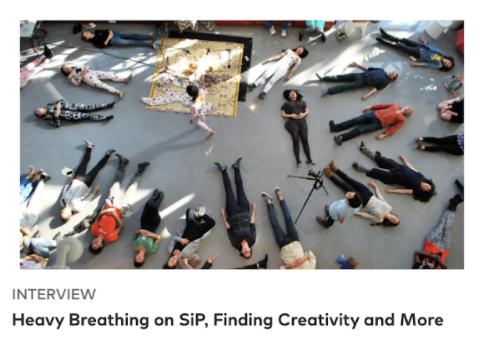
HEAVY BREATHING Q&A
Heavy Breathing’s co-founders Lisa Rybovich Crallé and Sophia Wang sat down with SFMOMA to chat about collaborating during the Bay Area’s Shelter-in-Place, inspirations for Heavy Breathing and its evolution since 2015 and hopes for the Bay Area’s art community, moving forward. Full transcript below:
Can you tell us a little bit about how the collective began?
Lisa: In 2014, while at an artist residency, I had some memorable conversations while walking with the other residents. During these walks, I became aware of how our conversations changed as we got winded. The more out of breath we became, the more we relied on physical gestures and the more expansive our conversations became. Sophia and I were in touch at the time and we wondered whether this simple idea of combining movement with dialogue could become the basis for an artist lecture series.
Sophia: In 2015, we presented our first season of 15 workshops that moved outside of typical artist talk conventions by using the model of a fitness class, and these took place in site-specific locations that included the Chinatown YMCA swimming pool in San Francisco and Lake Merritt in Oakland. The following year, we presented a 6-event series at the Berkeley Art Museum and Pacific Film Archive, adapting our model for the museum environment.
How has it evolved since then?
Sophia: In our third and fourth year we had limited funding, so we were just doing pop-up events, and that was great motivation for the evolution of Heavy Breathing AV, or HB/AV, where we’re commissioning artists to create either audio or video workshops that can be streamed or downloaded online. That opened up the audience and pool of artists we could work with. And it was a response to our material conditions, because we were able to do it on a much smaller budget — we weren’t producing live events.
What does working collaboratively in the age of social distancing mean to you? How has your collective been grappling with it?
Lisa: We were lucky that we had already begun engaging remotely through HB/AV, so the transition hasn’t been as rough as it could have been. We miss being able to share space with our community, and we often talk about Zoom fatigue and the inherent problems of being connected to a computer for so many hours a day. Those issues point back to the initial premise of Heavy Breathing and how important it is to get outside, move our bodies, and connect with one another, even if at arm’s length.
Sophia: The restrictions we’re experiencing right now aren’t that different — because we live in different cities, we have always worked at a distance. I would echo Lisa that it’s been a rich experience to figure out a way to create an engaging experience that occurs online. It was fun to use the new parameters as a formal challenge, which is, I would say, the spirit of Heavy Breathing and the intersection of bringing together movement and discourse.
What are some hopes you have for the Bay Area arts scene in a post-Covid future?
Lisa: I’m interested to see how the pandemic changes our relationship to proximity, particularly with regard to art and educational spaces. I teach at Berkeley City College and we’re grappling with these questions on a daily basis. How can we create the kind of intimacy and support that’s possible in a shared classroom or social environment, remotely? What will these experiences look like when we are able to be together safely again?
Any upheaval brings with it the promise of a fresh start, and I’d like to think that we will have a newfound appreciation for shared space and community when this situation is behind us. It’s not easy to maintain an optimistic outlook these days, but I am hopeful that the world we create will be better than the one we’ve left behind, meaning: more equity, more poetry and more connectedness.
Sophia: As Bay Area companies normalize working remotely, additional space might become available to others who do want to work together in the same space but don’t have tech funding to pay for those spaces. My hopes are really materially grounded. I was really inspired by Southern Exposure focusing their AltEx grant program on emergency relief funding for artists in this community, and specifically artists who may be experiencing additional hardship due to marginalized status. I would love to see all the major institutions recognize people’s basic needs, and turn towards this as a more normalized approach: making sure artists have the support they need to stay in the cities where they have an arts community, and to make a living wage to support both their work and their lives.
What are some books, films, pieces of art, or other media that you return to when you need inspiration, or that you consider foundational in some way, and why?
Lisa:
- Lecture-performance practitioners such as Joseph Beuys, Andrea Fraser, Coco Fusco, Adrian Piper, Yvonne Rainer, and Hito Steyerl.
- Gordon Hall’s work generally, and their Center for Experimental Lectures specifically as inspiration for Heavy Breathing.
- Artists who feel particularly relevant during the Covid-19 epidemic: Lygia Clark’s Relational Objects, Teching Hseih’s One Year performances, and pretty much everything by Felix Gonzalez-Torres.
Sophia:
- Dance and performance-based artists who centrally incorporate text, speech, writing and dialogue: Simon Forti’s News Animations and “moving the telling” practice, Jeanine Durning’s nonstopping practice and her solo inging, Bill T. Jones’ solo Breathing Show, Okwui Okpokwasili’s Poor People’s TV Room, David Thompson’s The Venus Knot, and Xavier Le Roy’s Product of Circumstances.
- Artists like Paul Chan, Ralph Lemon, and Martine Syms, who move between disciplines and have ongoing writing and publishing practices.
---------------------------------------------------------------
